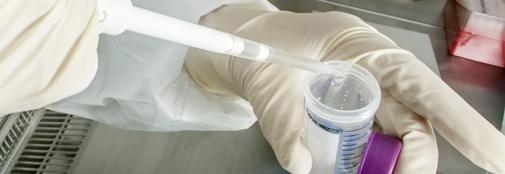Environmental DNA & Protein

DNA analysis
DNA (Deoxyribonucleic acid) encodes the genetic blueprint of organisms. Ancient DNA can be extracted from many organic materials and objects, including bone, hair, teeth, faeces, textiles, shells, plants and soil.
In an ancient DNA analysis, a relevant segment of DNA is mapped. Once it has been extracted in the laboratory, the DNA will be sequenced at the Danish National High Throughput Sequencing Centre where we use a variety of different methods to analyse data. In order to achieve the best results, it is crucial that the analysis is tailored to answer specific questions.
Ancient DNA analyses can provide evidence for:
- Sex and species assignment of skeletal specimens
- genetic ancestry from kinship to population affinity
- the presence of specific parasites and pathogens unattested by other proxies
The success of a genetic analysis is heavily dependent on the taphonomic conditions and how the specimen was excavated and curated. DNA preservation is typically poor in warm, humid environments, or in soils with non-neutral pH. Cold and dry environments are ideal. Archaeological features that trap and preserve organic refuse, like pits, latrines and accretional floors have yielded the best eDNA assemblages to date.
The Globe Institute is one of the world’s leading research institutions in this field and includes various research groups conducting ground-breaking research in the field of aDNA and environmental metagenomics.
Protein analysis
Protein analysis is the newest addition to the field of molecular research. The method represents a good alternative to DNA both in relation to badly preserved materials and in relation to the type of information the analysis may generate.
Proteins are essential building blocks in all organisms and perform a series of vital functions, as biological catalyst, as antigen and as hormone. Proteins are biological macromolecules and chemically they consist of amino acids tied together in polypeptide chains.
In the living organism proteins are subjected to constant destruction and regeneration, in fact an adult human synthesis several hundred grams of proteins every day. Proteins thus represent a comparatively more up-to-the-minute account of an organism and its responses to external influences, than for example aDNA.
Proteins typically occur in substantial amount and with great diversity in many biological materials. The analysis based on mass spectrometry sequencing therefore represents a particularly good alternative to aDNA, as it often better preserves better in many soil types. In many instances, it is possible to extract protein material where DNA is degraded.
The analysis lends itself to various research questions:
- species identification
- identification of archaeological materials, such as skin and bones
- identification of milk and gelatine (collagen)
- disease identification and immune system responses
The Globe Institute includes a group focused exclusively on proteomic research. This unit is at the forefront of the ancient proteomics wave worldwide.
Contact us to hear more about DNA and protein analyses and the possibilities this offers to the field of archaeology today.
Contact
Pernille Bangsgaard
Senior researcher
Research: Animal bones
Phone: +45 51 31 79 38
Email: pernille.bangsgaard@sund.ku.dk

